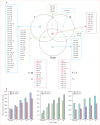Relation between microRNA expression and progression and prognosis of gastric cancer: a microRNA expression analysis
- PMID: 20022810
- PMCID: PMC4299826
- DOI: 10.1016/S1470-2045(09)70343-2
Relation between microRNA expression and progression and prognosis of gastric cancer: a microRNA expression analysis
Abstract
Background: Analyses of microRNA expression profiles have shown that many microRNAs are expressed aberrantly and correlate with tumorigenesis, progression, and prognosis of various haematological and solid tumours. We aimed to assess the relation between microRNA expression and progression and prognosis of gastric cancer.
Methods: 353 gastric samples from two independent subsets of patients from Japan were analysed by microRNA microarray. MicroRNA expression patterns were compared between non-tumour mucosa and cancer samples, graded by diffuse and intestinal histological types and by progression-related factors (eg, depth of invasion, metastasis, and stage). Disease outcome was calculated by multivariable regression analysis to establish whether microRNAs are independent prognostic factors.
Findings: In 160 paired samples of non-tumour mucosa and cancer, 22 microRNAs were upregulated and 13 were downregulated in gastric cancer; 292 (83%) samples were distinguished correctly by this signature. The two histological subtypes of gastric cancer showed different microRNA signatures: eight microRNAs were upregulated in diffuse-type and four in intestinal-type cancer. In the progression-related signature, miR-125b, miR-199a, and miR-100 were the most important microRNAs involved. Low expression of let-7g (hazard ratio 2.6 [95% CI 1.3-4.9]) and miR-433 (2.1 [1.1-3.9]) and high expression of miR-214 (2.4 [1.2-4.5]) were associated with unfavourable outcome in overall survival independent of clinical covariates, including depth of invasion, lymph-node metastasis, and stage.
Interpretation: MicroRNAs are expressed differentially in gastric cancers, and histological subtypes are characterised by specific microRNA signatures. Unique microRNAs are associated with progression and prognosis of gastric cancer.
Funding: National Cancer Institute.
Copyright 2010 Elsevier Ltd. All rights reserved.
Conflict of interest statement
The authors declared no conflicts of interest.
Figures


Comment in
-
Using microRNAs to understand cancer biology.Lancet Oncol. 2010 Feb;11(2):106-7. doi: 10.1016/S1470-2045(09)70386-9. Epub 2009 Dec 18. Lancet Oncol. 2010. PMID: 20022811 Free PMC article. No abstract available.
References
-
- Parkin DM, Bray F, Ferlay J, Pisani P. Global cancer statistics, 2002. CA Cancer J Clin. 2005;55:74–108. - PubMed
-
- Hohenberger P, Gretschel S. Gastric cancer. Lancet. 2003;362:305–15. - PubMed
-
- Yasui W, Yokozaki H, Fujimoto J, Naka K, Kuniyasu H, Tahara E. Genetic and epigenetic alterations in multistep carcinogenesis of the stomach. J Gastroenterol. 2000;35:111–15. - PubMed
-
- Stock M, Otto F. Gene deregulation in gastric cancer. Gene. 2005;360:1–19. - PubMed
-
- Li Q-L, Ito K, Sakakura C, et al. Causal relationship between the loss of RUNX3 expression and gastric cancer. Cell. 2002;109:113–24. - PubMed
Publication types
MeSH terms
Substances
Grants and funding
LinkOut - more resources
Full Text Sources
Other Literature Sources
Medical

